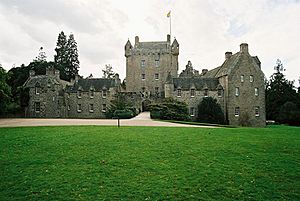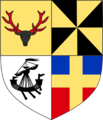Battle of Daltullich facts for kids
Quick facts for kids Battle of Daltullich |
|||||||
|---|---|---|---|---|---|---|---|
| Part of the Scottish clan wars | |||||||
 Cawdor Castle, the historic seat of the chiefs of Clan Calder and later the seat of the Campbells of Cawdor |
|||||||
|
|||||||
| Belligerents | |||||||
| Clan Campbell | Clan Calder | ||||||
| Commanders and leaders | |||||||
| Campbell of Inverliver | Hugh Calder Alexander Calder |
||||||
| Strength | |||||||
| Sixty men | |||||||
| Casualties and losses | |||||||
| Six, or seven, or eight, sons of Campbell of Inverliver killed | Unknown | ||||||
The Battle of Daltullich was a fight between two Scottish clans, the Clan Calder and the Clan Campbell. It happened in the autumn of 1499 near a place called Daltullich in Strathnairn, Scottish Highlands.
The main reason for the battle was a young girl named Muriel. She was the heiress, meaning she was supposed to inherit the leadership of the Clan Calder. The Campbells were taking Muriel away to marry her into their family, as had been agreed. But Muriel's uncles from the Calder clan chased after them, trying to stop the marriage from happening.
Why the Battle Happened
The leader of Clan Calder, known as the Thane of Cawdor, had a son named John Calder. John died, but he left behind two daughters, Janet and Muriel. Muriel was born after her father passed away, but she was still the rightful heir.
The old Thane wanted to change who would inherit his lands. He tried to make one of his other sons the heir instead of Muriel. However, a special legal document from the King in 1488 said that the lands would go to either a male or female descendant of his son John, which meant Muriel was the true heir.
Muriel's grandfather, Rose of Kilravock Castle, first planned for her to marry one of his own grandsons. But Rose had a legal problem with another powerful family. To help solve this, he made a deal with Archibald Campbell, 2nd Earl of Argyll. Argyll was a very important judge for all of Scotland. As part of the deal, Rose agreed to let Argyll arrange Muriel's marriage. So, in 1495, the King officially gave Argyll the right to decide who Muriel would marry. Muriel stayed at Kilravock Castle for a while.
The Fight at Daltullich
In the autumn of 1499, the Earl of Argyll sent a man named Campbell of Inverliver with sixty men to pick up Muriel. Their plan was to take her south for schooling or to Inveraray Castle.
As Inverliver and his men were traveling with Muriel near Strathnairn, they realized they were being followed. Muriel's uncles, Alexander and Hugh Calder, were chasing them with a larger group of men.
To protect Muriel, Inverliver quickly sent her ahead with six of his men. He then turned to face the Calders. To trick the Calders, Inverliver dressed a bundle of corn in some of Muriel's clothes and kept it at the back of his group.
The fight was fierce, and many lives were lost. Sadly, six, or even eight, of Campbell of Inverliver's own sons were killed in the battle. When Inverliver believed Muriel was far enough away and safe, he retreated, leaving the fake child behind for the Calders to find.
Another story says that Campbell of Inverliver hid a large cooking pot, pretending Muriel was underneath it. He then ordered his seven sons to defend the pot to the death while he rushed away with the real Muriel. All seven sons were killed. But when the Calders lifted the pot, Muriel wasn't there. By then, Campbell had gained so much time that it was useless for the Calders to keep chasing.
During the battle, Campbell of Inverliver is said to have cried out in Scottish Gaelic:
S fhada glaodh o' Lochow, 's fhada cobhair o' chlann dhaoine
This means in English:
Tis a far cry from Lochow, and a distant help from the children of my people
What Happened Next
For his brave actions, Campbell of Inverliver was given a valuable piece of land called Inverliver.
A story says that when Muriel was taken, her nurse bit off a part of her little finger. This was a secret way to identify Muriel later if needed.
After the Campbells arrived safely with Muriel, someone asked what would happen if Muriel died before she was old enough to marry. A man named Campbell of Auchinbreck famously replied that "she can never die, as long as a red-haired lassie can be found on either side of Loch Awe". This meant they would always find a way to keep the marriage agreement.
In 1502, a legal decision confirmed Muriel's right to be the heiress. The next year, the old Thane of Cawdor died, and his sons continued to argue about the inheritance for a while.
In 1510, Muriel married Sir John Campbell. He was a son of the Earl of Argyll. Sir John Campbell then received the estate of Calder. Their descendants became the Earls Cawdor and the leaders of the Clan Campbell of Cawdor.
To remember the marriage, the old hall of Cawdor Castle has the letters "S.I.C" and "D.M.C" carved into it, with the words "Ceri manimemineris mane". Some people think these letters stand for "S.J.C" (Sir John Campbell) and "M.C" (Muriel Calder). However, the style of the carvings suggests they might be from a later time.
Images for kids



